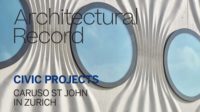It was the scene of incredible industry and a symbol of American might: just across the East River from lower Manhattan, the Brooklyn Navy Yard turned out some of the world's most celebrated warships throughout its 150-year-history, employing 70,000 workers at the peak of its production during World War II. When the 300-acre facility closed in 1966, dozens of its buildings fell into disrepair, as did the area surrounding it. After decades of neglect, that part of Brooklyn, like much of the rest of the borough, has transformed dramatically. First it became home to artists who located their studios within the vast warehouse spaces left behind; now its skyrocketing rents are pricing the middle class out of the neighborhood.
Additional Content:
Jump to credits & specifications
The beacon of Navy Green is a bold red eight-story building whose cheerful disposition belies its serious mission. Sheathed in a colorful patchwork of corrugated metal panels, it is a supportive-housing facility for chronically homeless people with mental illness and substance dependence. “Life's too short for subtlety,” explains Matthew Bremer, principal of New York–based Architecture in Formation. “We designed a billboard building to have a presence from the highway and on the street.”
This is the largest project Bremer and his small firm has done to date. FXFOWLE Architects, Navy Green's master planner and designer of some of its buildings, recommended the young Texan, who oversaw design development and worked with architect-of-record Curtis + Ginsberg on construction documents. Bremer's choice of metal for the main facade reflects the gritty nature of the area, but it also helps to inexpensively achieve his design statement: for the building to stand proud. The simple block-and-plank construction allowed the structure to go up quickly and economically, “like a cheap airport hotel,” according to the architect, who says the building was put together with “clumsy precision.” Owned and operated by the nonprofit Pratt Area Community Council (PACC) and built in part with funding from New York City under the supervision of its Department of Housing Preservation and Development, budget was obviously a concern.
Despite that, Bremer found ways to infuse the building, affectionately known as Big Red, with thoughtful design to help provide its long-term residents with a home, not just a shelter. Each of the 97 single-occupancy studios, many of which were awarded through a onetime lottery, is furnished with simple contemporary pieces. Beds, dressers, and lighting fixtures, as well as conference room furniture on the first floor, were acquired well below retail price with the help of the manufacturers.
The 285-square-foot identical studios line double-loaded corridors, painted a different sunny hue on each floor and punctuated with bold graphics. On the ground floor, a gracious double-height lobby provides a daylight-filled meeting area. To mitigate a 42-inch grade change from the lobby entrance to the courtyard behind the building, Bremer designed what he calls the “ramphitheater.” The innovative gathering spot incorporates bench seating around a snaking concrete ADA-compliant ramp. Creeping up the wall and ceiling around this feature is a vine of T8 fluorescent tubes that illuminate it at night. A bridge spanning the double-height space contains a small informal lounge for residents, which Bremer fought to include.
Past the lobby are offices for caseworkers from the Department of Social Services, with whom the residents must regularly check in. A community room accommodates classes and more formal tenant meetings. The controlled environment restricts guests and also limits units to single residents without children, but the building's position within the larger Navy Green development offers occupants access to the shared central courtyard. “That is uncommon for an American paradigm,” explains Drew Kiriazides, PACC chief real estate development officer. Landscape architects Todd Rader and Amy Crews designed this coveted amenity as an open tree-lined plaza.
“This was not a top-down development,” Kiriazides points out. “It was planned in full by the community, which came together years ago to decide on best uses for this location.” As the Brooklyn Navy Yard draws upon its illustrious past to restore and rebuild, collaborative, mixed-use, nonexclusionary projects like Navy Green—and, in particular, design-conscious pursuits like Big Red—point to the neighborhood's promising future.
CreditsOwner: Pratt Area Community Council, Deb Howard, Executive Director, Drew Kiriazides, Chief Real Estate Development Officer, Tammy Ferlisi, Director of Housing Development
Architect: (Design Architect) Personnel in architect's firm who should receive special credit: Architect of record: (Executive Architect)
Engineer(s): Structural: MEP:
Consultant(s): Landscape: Rader Crews Landscape Architecture LLC, Todd Rader Lighting: Filament33 Inc., Marianne Maloney, Principal Energy & Environmental: Steven Winters Associates
General contractor: Mega Contracting Inc.
Photographer(s): Tom Powel Size: 56,000 square feet Total construction cost: $16.8 million Completion date: May 2012 |
SpecificationsStructural system Concrete block and precast concrete plank with steel framing and cast concrete at the entry/lobby. Exterior cladding Masonry: Metal Panels: Metal/glass curtain wall: Precast concrete: Roofing Built-up roofing: Windows Metal frame: Glazing Glass: Doors Entrances: Metal doors: Hardware Locksets: Closers: Exit devices: Pulls: Security devices: Interior finishes Acoustical ceilings: Cabinetwork and custom woodwork: Paints and stains: Plastic laminate: Solid surfacing: Special surfacing: Floor and wall tile: Resilient flooring: Carpet:Tandus Furnishings Office furniture: Fixed seating: Chairs: Harter,through EvensonBest Tables: Hon, Versteel, through EvensonBest Other furniture: Lighting Interior ambient lighting: Downlights: Exterior: Conveyance Elevators/Escalators: Plumbing Elkay (drinking fountain) |

















Post a comment to this article
Report Abusive Comment